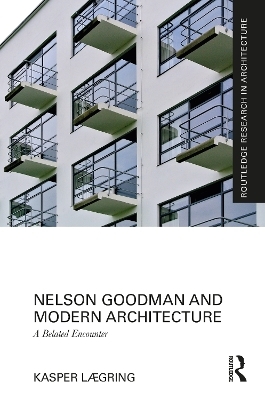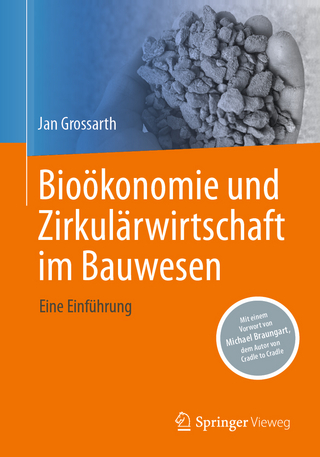
Nelson Goodman and Modern Architecture
Routledge (Verlag)
978-1-032-34742-4 (ISBN)
This book orchestrates a convergence of two discourses from the 1960s—Nelson Goodman’s aesthetic theory on one side and critiques of modern architecture articulated by figures like Peter Blake, Charles Jencks, and Robert Venturi/Denise Scott Brown on the other. Grounded in Goodman’s aesthetic theory, the book explores his conceptual framework within the context of modern architecture.
At the heart of the investigation lies Goodman’s concept of exemplification. While his notion of denotation pertains to representational elements, often ornaments, in architecture, exemplification accentuates specific formal properties at the expense of others, including color, spatial orientation, transparency, seriality, and the like. Supplemented by findings from phenomenology, the book traces these effects in buildings, notably those by Ludwig Mies van der Rohe, Walter Gropius, Le Corbusier, and Frank Lloyd Wright—all key figures in the critiques of modern architecture.
Employing Goodman’s framework, the book aims to address accusations of emptiness and alienation directed at modern architecture in the postwar era. It illustrates that modern architecture symbolizes aesthetically in a fundamentally different way than architecture from earlier periods.
This book will be of interest to architects, artists, researchers, and students in architecture, architectural history, theory, cultural theory, philosophy, and aesthetics.
Kasper Lægring is a theorist of architecture and the arts, a curator, and currently a New Carlsberg Foundation Postdoctoral Fellow in Art History at Aarhus University. He is serving as the Second Vice President of the European Architectural History Network for the period 2024–2026 (with Panagiotis Farantatos). With research degrees in architecture (MS, University of Pennsylvania; PhD, The Royal Danish Academy School of Architecture) and art history (Mag.art., University of Copenhagen), he has received recognition such as the Gold Medal of the University of Copenhagen. His studies and research have been supported by numerous prestigious institutions, including the J. William Fulbright Commission, the New Carlsberg Foundation, and the ZEIT-Stiftung Ebelin und Gerd Bucerius. Some recent notable publications include contributions to A Cultural History of the Avant-Garde in the Nordic Countries (Brill, 2022) and The Contested Territory of Architectural Theory (Routledge, 2022). This book is a revised and expanded version of his PhD dissertation.
Acknowledgements
List of Figures
Chapter 1: Introduction
Reckoning with the critique of modern architecture
A Goodmanian take on modern architecture and its critiques
Defining the object of study
Problems of demarcation
The ideological basis for modern architecture in functionalist theory
Current research into the praxis of modern architecture
Chapter 2: Applying Goodman’s aesthetic theory to architecture
Aesthetics and cognition
Aesthetics and language
Goodman as nominalist
Right or wrong rather than true or false
When does architecture take place? Goodman’s rejection of competing theories
Languages of Art
Symbol systems and symbol schemes
Syntactic and semantic, notation, digital and analog
Imperfect notational systems: Notational schemes
Allographic, autographic and the steps of the design process
Notational approaches: Score and script
Notation and mixed symbol systems in architecture
Denotation
Fictitious denotation
Exemplification
Exemplification in modern architecture
Expression (metaphorical exemplification)
Feelings or moods?
Complex and mediate modes of reference: Allusion, variation, style
Allusion
Variation
Style
Chapter 3: Symbolization in pre-modern architecture
Renaissance architecture
Mannerist architecture
Baroque architecture
Rococo architecture
Neoclassical architecture
Romanticist impulses
Historicist architecture
Chapter 4: Symbolization in the early phases of modern architecture
The Chicago School
Wainwright Building
Art Nouveau, Jugendstil, Wiener Secession, and Catalan Modernisme
Maison Coilliot
Maison Horta
Majolikahaus
Casa Milà
Willow Tearooms
Adolf Loos
Looshaus
Expressionist architecture
Het Schip
Einsteinturm
Glass architecture
Chapter 5: The aesthetic implications of the critique of modern architecture
The International Style exhibition in 1932 as a compass
The aesthetically oriented critique of modern architecture, circa 1970
Chapter 6: Symbolization in modern architecture
The International Style: Mies van der Rohe and the minimalism of glass and steel
Illinois Institute of Technology
General means of aesthetic symbolization in Mies’ formalistic architecture
The International Style: Gropius, Bauhaus, and the factory aesthetic
The Bauhaus building in Dessau
Late works by Gropius
Formalism and classicism in American federal and corporate International Style
The International Style: Le Corbusier and Purism
Les Quartiers Modernes Frugès in Pessac
The white, cubist aesthetic of the villas of Loos and Le Corbusier
Le Corbusier’s late works and the Brutalism of béton brut
Unité d’habitation in Marseille
Notre-Dame-du-Haut at Ronchamp
The imprint of Brutalism on late modernism
Frank Lloyd Wright and organic modernism
Late works by Wright
Fallingwater
From Alvar Aalto to the notion of another modernism
Chapter 7: Conclusion
The hegemony of exemplification in modern architectural praxis
The architecture of formalism: symbolic rather than silent
Bibliography
Index
| Erscheinungsdatum | 22.08.2024 |
|---|---|
| Reihe/Serie | Routledge Research in Architecture |
| Zusatzinfo | 2 Line drawings, black and white; 38 Halftones, black and white; 40 Illustrations, black and white |
| Verlagsort | London |
| Sprache | englisch |
| Maße | 156 x 234 mm |
| Gewicht | 710 g |
| Themenwelt | Kunst / Musik / Theater ► Kunstgeschichte / Kunststile |
| Geisteswissenschaften ► Philosophie | |
| Naturwissenschaften ► Biologie ► Ökologie / Naturschutz | |
| Technik ► Architektur | |
| ISBN-10 | 1-032-34742-2 / 1032347422 |
| ISBN-13 | 978-1-032-34742-4 / 9781032347424 |
| Zustand | Neuware |
| Haben Sie eine Frage zum Produkt? |
aus dem Bereich


